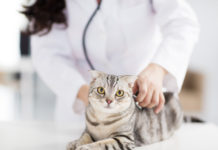Question: I would like some information as to how to treat a female cat that was spayed at least two years ago. Every two or three months, she seems to be in terrible pain for about three or four days. I am desperate to be able to give this cat some relief. I was told that part of the ovary was not removed during her operation. The advice of my local veterinarian is to operate, but I was told that there might be help by administrating a type of birth control pill. I am reluctant to experiment with this idea, and hope that you may give me some direction as to a medication that might help in this case. I would appreciate any suggestions that you may have.
Answer: First, its important that you work with your veterinarian to determine whether your cat is indeed in pain or is merely in estrus (heat). Actually the two can look a lot the alike. Frenzied owners have called me, absolutely convinced that their young un-spayed female cat was in severe pain when, in fact, she was only in heat. Increased attention seeking, rolling around on the floor, incessant crying (more accurately, alarming sounding yowling), sideways deviation of the tail, treading of the hindlegs, and upward pointing of the rear end in a rather promiscuous-like fashion, are all typical estrus behaviors. These kitties will even attract male cats if there are any around.
All this could be easily confused with a pain response, but your veterinarian should be able to help you tell the difference. Though not usually necessary, special diagnostic tests can tell whether a cat is in heat.
Is It Somebodys Fault?
So how can estrus, an estrogen-induced behavior, happen in a cat thats had her bodys major source of estrogen – her ovaries – removed (as happens when shes spayed)? With few exceptions, its because part of an ovary was left behind. Veterinarians call this phenomenon the ovarian remnant syndrome. It seems to go against reason, but heat cycles may resume anywhere from a few weeks to many years – up to nine years in one report – after spaying.
Admittedly, carelessness on the part of the surgeon is the likely cause in some cases, but before you pick up the phone to yell at your veterinarian, let me relate a little tale taken from my own experience. In my earlier days as a veterinarian, I manned a veterinary emergency/critical care facility in a major metropolitan area. At about 2 oclock one morning, I was presented with a little cat that had been struck by a car. Not a very unusual event, I fear, but this kitty was extra special: She was due to deliver kittens in short order, and the accident had ruptured her uterus.
I had to perform emergency surgery, but miraculously, both she and her unborn kittens came shiningly through the whole ordeal. (One of her kittens had even been expelled from the torn uterus and was lying in the abdominal cavity, but because the umbilical cord was still intact, even this little ones life was spared.) The point of my story is this: Scattered all along the cord-like structure that attached one of her ovaries to its blood supply were tiny pieces of ovarian tissue. It was easy for me to see the tissue because the ovarian tissue was active and the incision was big enough to allow me to see the whole reproductive tract. But if this cat had been presented for spaying under more normal circumstances, its entirely possible that the unusually placed tissue would have been missed. Such extraovarian tissue isnt all that unusual and is, in my opinion, one of the major causes of ovarian remnant syndrome.
Medication or Surgery?
Surgical removal of the remaining ovarian tissue is by far the best option. The few medications able to suppress estrus in cats carry some significant side effects and they would need to be given lifelong. There are some issues, though, that may make the tissue difficult to find and remove. First, I would expect it to be quite small; second, it may be enmeshed in scar tissue and hard to visualize. This being the case, your veterinarian may encourage you to have the surgery performed by a veterinary surgical specialist.
He/she will probably also recommend doing the procedure when the tissue is the most visible – either during estrus or a couple of weeks after giving a hormone that stimulates ovarian activity. Once the extraovarian tissue is removed, your kitty will cease to go into heat.



